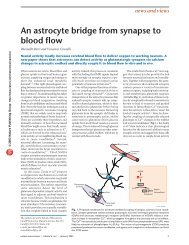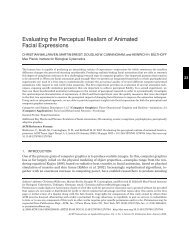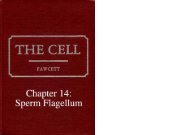Chapter 12: Centrioles
Chapter 12: Centrioles
Chapter 12: Centrioles
You also want an ePaper? Increase the reach of your titles
YUMPU automatically turns print PDFs into web optimized ePapers that Google loves.
- Proximal<br />
CENTRIOLAR ADJUNCT<br />
During formation of a cilium or flagellum, only subunits a and b of the centriolar<br />
triplets serve as nucleation sites for formation of the doublets of the axoneme. A unique<br />
behavior of the proximal centriole during spermatogenesis demonstrates, however, that<br />
subunit c can serve as a site for nucleation of tubulin during elongation of the triplets to<br />
form the transient organelle known as the centriolar adjunct.<br />
Early in mammalian spermiogenesis, the pair of centrioles takes up a position in<br />
the peripheral cytoplasm with the end of one member of the pair adjacent to the cell<br />
membrane. This relationship initiates the development of the flagellum at the end of the<br />
distal centriole (A). Soon thereafter, fine filamentous material gathers around the distal<br />
end of the proximal centriole (B). The centriole then increases in length by accretion<br />
and polymerization of this material at its end. This process continues for some time<br />
after the centrioles and base of the flagellum have moved inward and become lodged<br />
in the implantation fossa in the caudal pole of the nucleus (C). As will be illustrated<br />
in subsequent micrographs, this newly formed appendage is not identical to the centriole<br />
from which it arises.<br />
The centriolar adjunct may attain a length two or three times that of the centriole.<br />
It then disappears, leaving no residue in the mature spermatozoon (D). It has been<br />
found in all mammalian species thus far examined but its function remains unknown.<br />
Flagellum<br />
Proximal<br />
centriole<br />
Outer dense<br />
fibers<br />
M itochondrial<br />
sheath<br />
568<br />
Figure 313. Diagram of formation of the centriolar adjunct. (From Fawcett, in Genetics of the<br />
Spermatozoon, Bogtrykkeriet Forum, Copenhagen, 1971.)<br />
Figure 313









